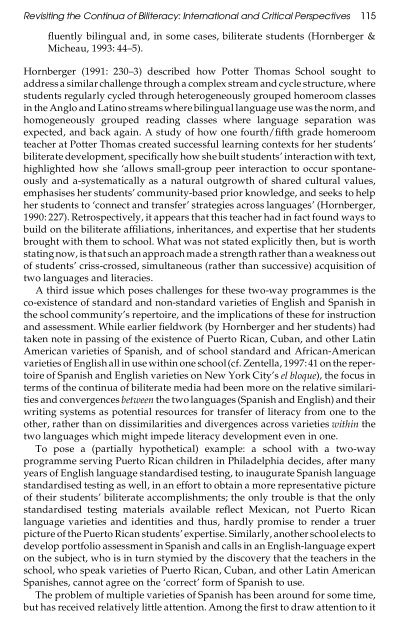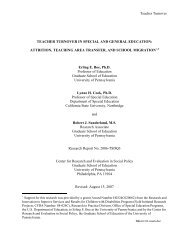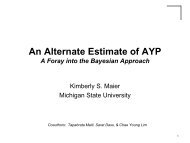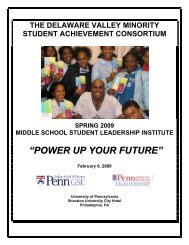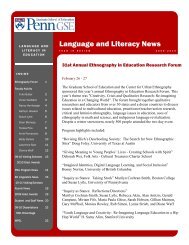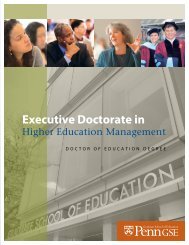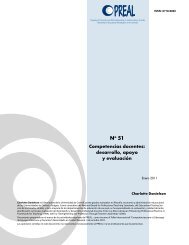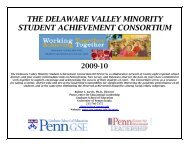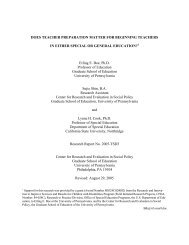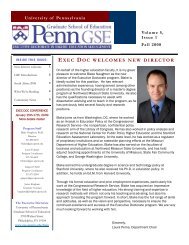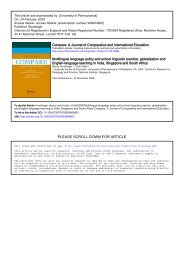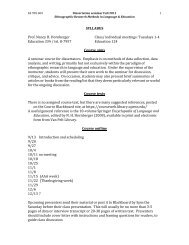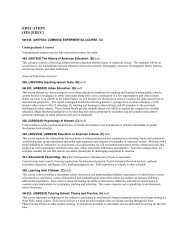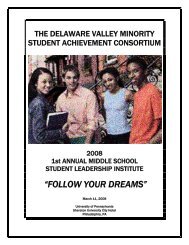Revisiting the Continua of Biliteracy - Penn GSE - University of ...
Revisiting the Continua of Biliteracy - Penn GSE - University of ...
Revisiting the Continua of Biliteracy - Penn GSE - University of ...
Create successful ePaper yourself
Turn your PDF publications into a flip-book with our unique Google optimized e-Paper software.
<strong>Revisiting</strong> <strong>the</strong> <strong>Continua</strong> <strong>of</strong> <strong>Biliteracy</strong>: International and Critical Perspectives 115<br />
fluently bilingual and, in some cases, biliterate students (Hornberger &<br />
Micheau, 1993: 44–5).<br />
Hornberger (1991: 230–3) described how Potter Thomas School sought to<br />
address a similar challenge through a complex stream and cycle structure, where<br />
students regularly cycled through heterogeneously grouped homeroom classes<br />
in <strong>the</strong> Anglo and Latino streams where bilingual language use was <strong>the</strong> norm, and<br />
homogeneously grouped reading classes where language separation was<br />
expected, and back again. A study <strong>of</strong> how one fourth/fifth grade homeroom<br />
teacher at Potter Thomas created successful learning contexts for her students’<br />
biliterate development, specifically how she built students’ interaction with text,<br />
highlighted how she ‘allows small-group peer interaction to occur spontaneously<br />
and a-systematically as a natural outgrowth <strong>of</strong> shared cultural values,<br />
emphasises her students’ community-based prior knowledge, and seeks to help<br />
her students to ‘connect and transfer’ strategies across languages’ (Hornberger,<br />
1990: 227). Retrospectively, it appears that this teacher had in fact found ways to<br />
build on <strong>the</strong> biliterate affiliations, inheritances, and expertise that her students<br />
brought with <strong>the</strong>m to school. What was not stated explicitly <strong>the</strong>n, but is worth<br />
stating now, is that such an approach made a strength ra<strong>the</strong>r than a weakness out<br />
<strong>of</strong> students’ criss-crossed, simultaneous (ra<strong>the</strong>r than successive) acquisition <strong>of</strong><br />
two languages and literacies.<br />
A third issue which poses challenges for <strong>the</strong>se two-way programmes is <strong>the</strong><br />
co-existence <strong>of</strong> standard and non-standard varieties <strong>of</strong> English and Spanish in<br />
<strong>the</strong> school community’s repertoire, and <strong>the</strong> implications <strong>of</strong> <strong>the</strong>se for instruction<br />
and assessment. While earlier fieldwork (by Hornberger and her students) had<br />
taken note in passing <strong>of</strong> <strong>the</strong> existence <strong>of</strong> Puerto Rican, Cuban, and o<strong>the</strong>r Latin<br />
American varieties <strong>of</strong> Spanish, and <strong>of</strong> school standard and African-American<br />
varieties <strong>of</strong> English all in use within one school(cf. Zentella, 1997:41 on <strong>the</strong> repertoire<br />
<strong>of</strong> Spanish and English varieties on New York City’s el bloque), <strong>the</strong> focus in<br />
terms <strong>of</strong> <strong>the</strong> continua <strong>of</strong> biliterate media had been more on <strong>the</strong> relative similarities<br />
and convergences between <strong>the</strong> two languages (Spanish and English) and <strong>the</strong>ir<br />
writing systems as potential resources for transfer <strong>of</strong> literacy from one to <strong>the</strong><br />
o<strong>the</strong>r, ra<strong>the</strong>r than on dissimilarities and divergences across varieties within <strong>the</strong><br />
two languages which might impede literacy development even in one.<br />
To pose a (partially hypo<strong>the</strong>tical) example: a school with a two-way<br />
programme serving Puerto Rican children in Philadelphia decides, after many<br />
years <strong>of</strong> English language standardised testing, to inaugurate Spanish language<br />
standardised testing as well, in an effort to obtain a more representative picture<br />
<strong>of</strong> <strong>the</strong>ir students’ biliterate accomplishments; <strong>the</strong> only trouble is that <strong>the</strong> only<br />
standardised testing materials available reflect Mexican, not Puerto Rican<br />
language varieties and identities and thus, hardly promise to render a truer<br />
picture <strong>of</strong> <strong>the</strong> Puerto Rican students’ expertise. Similarly, ano<strong>the</strong>r school elects to<br />
develop portfolio assessment in Spanish and calls in an English-language expert<br />
on <strong>the</strong> subject, who is in turn stymied by <strong>the</strong> discovery that <strong>the</strong> teachers in <strong>the</strong><br />
school, who speak varieties <strong>of</strong> Puerto Rican, Cuban, and o<strong>the</strong>r Latin American<br />
Spanishes, cannot agree on <strong>the</strong> ‘correct’ form <strong>of</strong> Spanish to use.<br />
The problem <strong>of</strong> multiple varieties <strong>of</strong> Spanish has been around for some time,<br />
but has received relatively little attention. Among <strong>the</strong> first to draw attention to it


